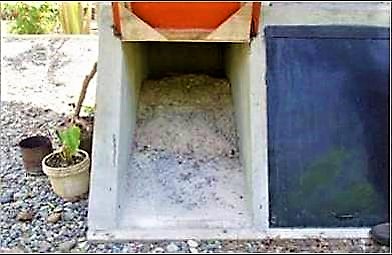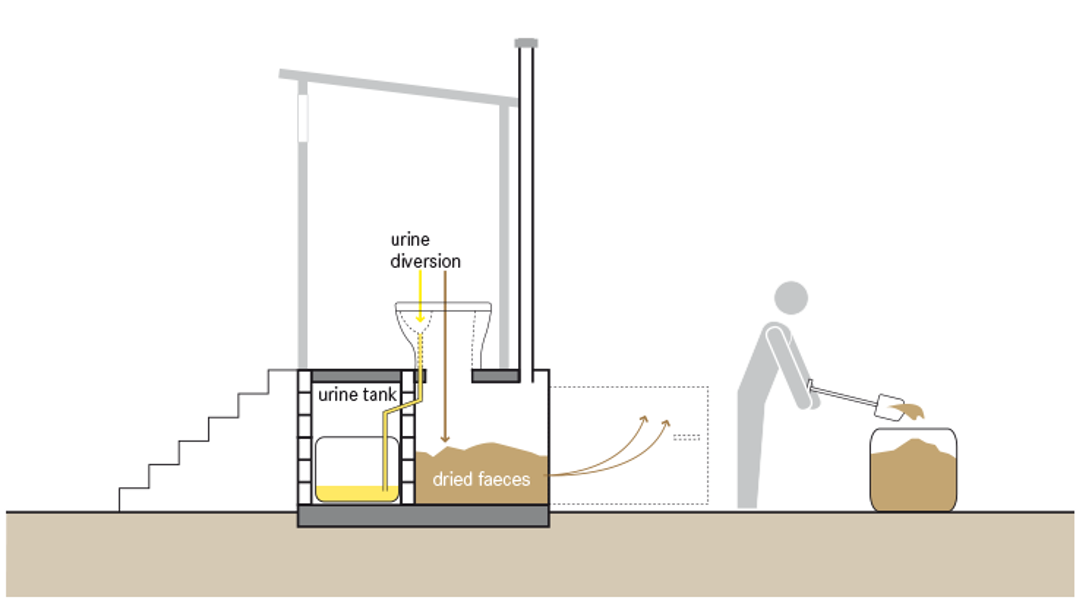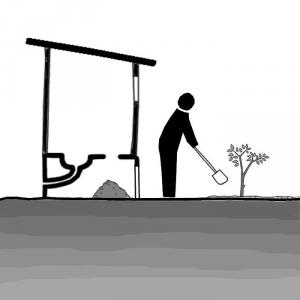When faeces are stored in the absence of moisture (i.e., urine , anal cleansing water or flushing and washing water ), they dehydrate into a crumbly, white-beige coarse, flaky material or powder. The moisture naturally present in the faeces evaporates and/or is absorbed by the drying material (e.g., ash, sawdust, lime) that is added to them. Dried faeces can be used as a soil conditioner due to its high organic matter content and is a good phosphorus and potassium fertilizer, which also contributes considerable amounts of nitrogen .
| المُدخلات | المُخرَجات |
|---|---|
Compost / Biosolids, Food Products |
In a dehydration toilet, the excreta inside the processing vault are dehydrated with the help of sun, natural evaporation and ventilation. Dehydration is different from composting because the organic material present is not degraded or transformed; only the moisture is removed. Faeces will reduce in volume by about 75% after dehydration. Completely dry faeces are a crumbly, powdery substance. The shells and carcasses of worms and insects in the faeces also dehydrate and becomes part of the dried material.
The primary motivation for dehydrating the faeces is to significantly reduce the amount of pathogens in the faeces over time. The material is rich in carbon and nutrients, but may still contain protozoan cysts or oocysts (spores that can survive extreme environmental conditions and be re-animated under favourable conditions) and other pathogens. The degree of pathogen inactivation will depend on the temperature, the pH (using ash or lime raises the pH) and storage time. The addition of calcium carbonates, contained in lime or wood ashes added as drying material, helps to raise the pH, and thus accelerate the process of pathogen inactivation. It is generally accepted that faeces should be stored between 6 to 24 months, although pathogens may still exist after this time (refer WHO guidelines on excreta use in agriculture (Volume IV) for specific guidance). In some cases (e.g. centralized storage and reuse), a secondary treatment (e.g. small scale composting or centralised composting, or terra preta sanitation) of dehydrated faeces should always be considered (if possible) as an additional barrier to inactivate pathogens (and here most importantly Ascaris).
If the drying is fast and a low moisture level is achieved, the losses of both organic matter and nitrogen are small. Compared to composting, dry storage of the faeces recycles more organic matter and nitrogen to the soil, but the organic matter is less stable. Dried faecal matter is a complete phosphorus and potassium fertiliser, which also contributes considerable amounts of nitrogen (JOENSSON et al. 2004).
The material can be mixed into soil for agriculture (depending on acceptance) or safely mixed into soil or buried elsewhere. Extended storage is also an option if there is no immediate use for the material (see surface disposal and storage). As the breakdown of organic material in dehydrating conditions is slow, toilet paper or similar objects placed in the chamber will not disintegrate quickly. Toilet paper can therefore either be handled separately, or be composted in a secondary treatment process.

Faeces that are dried and kept at between 2 and 20° C should be stored for 1.5 to 2 years before being used at the household or regional level (see also dehydration and storage of faeces). At higher temperatures (i.e., greater than 20° C), storage over 1 year is recommended to inactivate Ascaris eggs (a type of parasitic worm). A shorter storage time of 6 months is required if the faeces have a pH above 9 (i.e., adding ash or lime increases the pH). WHO guidelines on excreta use in agriculture (Volume IV) concerning the use of excreta in agriculture should be consulted beforehand.

Dehydrated faeces can be mixed into soil, buried or composted at home or in a community based composting site depending on acceptance. Nutrients will be available to plants directly or after further decomposition of the dehydrated material. The addition of wood ashes not only enhances the inactivation process of pathogens due to the rise of pH, but can also increase the potassium (K) content of the final product.
The application rate of faeces can be based on local recommendations for the use of phosphorus-based fertilisers and analysis of the phosphorus content of the faecal product. This gives a rather low application rate, and the improvement of the crop due to the added organic matter is hard to distinguish. As the dry faeces can also considerably improve the soil structure and water-holding capacities, they are often applied at much higher rates. If organic matter (wood chips) or ashes are added to the faeces during collection and processing, these will improve the buffering capacity and the pH of the soil, which is especially important on soils with low pH (ECOSANRES 2008).
The average person produces around 50 L of faeces each year. This amount of faeces will fertilise 1.5 to 3.0 m2 of crop if the application is made according to organic content. If application is instead based on phosphorus content, it will be enough to fertilise 200-300 m2 (ECOSANRES 2008).
Because faeces contain large amounts of P, which is important for the development of roots, faeces should be applied prior to sowing or planting. Faeces must be applied at a depth where the soil stays moist, because the P only becomes available to the plants when it dissolves into the soil liquid, and the water-holding and buffering capacity of the organic matter are fully utilised only in moist conditions. Thus, applied faeces should be incorporated into the soil and covered. However, faeces should not be applied at depths exceeding the rooting depth.
The handling and use of dried faeces may not be acceptable to some people. However, because dehydrated faeces should be dry, crumbly, and odour free, using them might be easier to accept than manure or sludge. Dry faeces are a hostile environment for organisms and they do not survive long in it. If water or urine is mixed with the drying faeces, however, odours and organisms may become problematic because bacteria easily survive and multiply in wet faeces. Warm, moist environments are conducive to anaerobic processes, which can generate offensive odours.
Dehydrated faeces should not be applied to crops less than one month before they are harvested. This waiting period is especially important for crops that are consumed raw.
For additional precaution faeces may also applied to crops that grow above the ground (e.g. fruit trees or bushes). To heighten acceptance, it can also be used for non-food crops that need fertilisations (animal fodder, wood etc.).
When removing dehydrated faeces from dehydration vaults, care must be taken to prevent the powder from blowing and being inhaled. Emptying of vaults on windy days must therefore be avoided. Workers should wear appropriate protective clothing.
Faeces should be kept as dry as possible during storage . If by accident, water or urine enters and mixes with drying faeces, more ash, lime or dry soil should be added to help absorb the moisture. Prevention is the best way to keep faeces dry.
Dried faeces are not as useful as a soil amendment as composted faeces. However, they contain significant amounts of phosphorus, important in the early stage of plant growth and they can help to replenish poor soil and to boost the carbon and water-storing properties of soil, while posing low risk of pathogen transmission. For hygiene reasons, faeces should be incorporated into the soil and covered by a soil upper layer. Also the fertilisation of vegetables eaten raw should be avoided. The application of faeces is suited for tree plantations or the cultivation of cereals (e.g. wheat), potatoes, yam and other tuberous crops (see also WHO guidelines on excreta use in agriculture (Volume IV)).
Urine-diversion. Ecological Sanitation Systems in South Africa
This publication includes directions for making a simple urinal using a 5 litre plastic container.
AUSTIN, A. DUNCKER, L. (2002): Urine-diversion. Ecological Sanitation Systems in South Africa. Ecological Sanitation Systems in South Africa. Pretoria: Council for Scientific and Industrial Research (CSIR)Guidelines on the Use of Urine and Faeces in Crop Production. Factsheet
A 2-page factsheet summarizing the EcoSanRes ‘Guidelines on the Use of Urine and Faeces in Crop Production’ publication with short information on urine as a fertilizer, application rates etc.
ECOSANRES (2008): Guidelines on the Use of Urine and Faeces in Crop Production. Factsheet. (pdf presentation). (= EcoSanRes Factsheet , 6 ). Stockholm: Stockholm Environment Institute URL [Accessed: 31.05.2019]Guidelines on the Use of Urine and Faeces in Crop Production
These guidelines provide a thorough background on the use of urine (and faeces) for agricultural purposes. Aspects discussed are requirements for plant growth, nutrients in excreta, hygiene aspects, and recommendations for cultivation. It provides detailed guidance on the use of urine for purposes.
JOENSSON, H. RICHERT, A. VINNERAAS, B. SALOMON, E. (2004): Guidelines on the Use of Urine and Faeces in Crop Production. (= EcoSanRes Publications Series , 2004 ). Stockholm: EcoSanRes URL [Accessed: 17.04.2012]Technology Review of Urine-Diverting Dry Toilets (UDDTs)
This publication offers a complete overview of UDDT functions, design considerations, common operation and maintenance issues and generalised installation costs. Its focus is on applications in developing countries and countries in transition, although UDDTs are also applicable in developed countries.
RIECK, C. MUENCH, E. HOFFMANN, H. (2012): Technology Review of Urine-Diverting Dry Toilets (UDDTs). Overview on Design, Management, Maintenance and Costs. (= Technology Review ). Eschborn: German Agency for Technical Cooperation (GTZ) GmbH URL [Accessed: 11.05.2019]Guidelines for the Safe Use of Urine and Faeces in Ecological Sanitation Systems
These guidelines provide a thorough background on the safe use of urine and faeces for agricultural purposes. Aspects like the health risk associated we the use of human excreta in agriculture and how to limit them are discussed.
SCHOENNING, C. STENSTROEM, T. A. (2004): Guidelines for the Safe Use of Urine and Faeces in Ecological Sanitation Systems. (= EcoSanRes Publication Series, Report 2004-1 ). Stockholm: Stockholm Environment InstituteCompendium of Sanitation Systems and Technologies. 2nd Revised Edition
This compendium gives a systematic overview on different sanitation systems and technologies and describes a wide range of available low-cost sanitation technologies.
TILLEY, E. ULRICH, L. LUETHI, C. REYMOND, P. ZURBRUEGG, C. (2014): Compendium of Sanitation Systems and Technologies. 2nd Revised Edition. Duebendorf, Switzerland: Swiss Federal Institute of Aquatic Science and Technology (Eawag) URL [Accessed: 28.07.2014] PDFGuidelines for the safe use of wastewater excreta and greywater. Volume IV. Excreta and Greywater Use in Agriculture
Volume IV of the Guidelines for the Safe Use of Wastewater, Excreta and Greywater recognizes the reuse potential of wastewater and excreta (including urine) in agriculture and describes the present state of knowledge as regards potential health risks associated with the reuse as well as measures to manage these health risks following a multi-barrier approach.
WHO (2006): Guidelines for the safe use of wastewater excreta and greywater. Volume IV. Excreta and Greywater Use in Agriculture. Geneva: World Health Organisation (WHO) URL [Accessed: 09.05.2019] PDFEcological Sanitation - revised and enlarged edition
This book is one of the most fundamental and important books that defined the concept of ecological sanitation. The first version came out in 1998 - this version presents the findings of over ten years of research and development in ecological sanitation supported by SIDA (Swedish International Development Cooperation Agency).
WINBLAD, U. SIMPSON-HERBERT, M. (2004): Ecological Sanitation - revised and enlarged edition. (pdf presentation). Sweden: Stockholm Environment Institute URL [Accessed: 04.08.2010]Excreta Use in Agriculture, Lecture taken from the XU Ecosan Course
Compendium of Sanitation Systems and Technologies (Arabic)
This is the Arabic version of the Compendium of Sanitation Systems and Technologies. The Compendium gives a systematic overview on different sanitation systems and technologies and describes a wide range of available low-cost sanitation technologies.
TILLEY, E. ULRICH, L. LUETHI, C. REYMOND, P. SCHERTENLEIB, R. ZURBRUEGG, C. (2014): Compendium of Sanitation Systems and Technologies (Arabic). 2nd Revised Edition. Duebendorf, Switzerland: Swiss Federal Institute of Aquatic Science and Technology (Eawag) PDFUrine-diversion. Ecological Sanitation Systems in South Africa
This publication includes directions for making a simple urinal using a 5 litre plastic container.
AUSTIN, A. DUNCKER, L. (2002): Urine-diversion. Ecological Sanitation Systems in South Africa. Ecological Sanitation Systems in South Africa. Pretoria: Council for Scientific and Industrial Research (CSIR)Guidelines on the Use of Urine and Faeces in Crop Production. Factsheet
A 2-page factsheet summarizing the EcoSanRes ‘Guidelines on the Use of Urine and Faeces in Crop Production’ publication with short information on urine as a fertilizer, application rates etc.
ECOSANRES (2008): Guidelines on the Use of Urine and Faeces in Crop Production. Factsheet. (pdf presentation). (= EcoSanRes Factsheet , 6 ). Stockholm: Stockholm Environment Institute URL [Accessed: 31.05.2019]Urine and Faeces as Fertilizers in the CREPA Network
Presentation on experiences with the use of urine (and faeces) in agriculture including research results, conducted taste tests and calculations on the fertiliser value.
DAGERSKOG, L. SuSanA (2009): Urine and Faeces as Fertilizers in the CREPA Network. pdf presentation. (= SuSanA presentation WG , 5 ). Ouagadougou: Sustainable Sanitation Alliance URL [Accessed: 27.05.2019]Guidelines on the Use of Urine and Faeces in Crop Production
These guidelines provide a thorough background on the use of urine (and faeces) for agricultural purposes. Aspects discussed are requirements for plant growth, nutrients in excreta, hygiene aspects, and recommendations for cultivation. It provides detailed guidance on the use of urine for purposes.
JOENSSON, H. RICHERT, A. VINNERAAS, B. SALOMON, E. (2004): Guidelines on the Use of Urine and Faeces in Crop Production. (= EcoSanRes Publications Series , 2004 ). Stockholm: EcoSanRes URL [Accessed: 17.04.2012]Methods of Using "Toilet Compost" in Agriculture
This document gives a simple overview over toilet compost, its preparation and fields of application.
MORGAN, P. (2010): Methods of Using "Toilet Compost" in Agriculture. Stockholm : Ecological Sanitation Research (EcoSanRes), Stockholm Environment Institute (SEI) URL [Accessed: 01.06.2019]Technology Review of Urine-Diverting Dry Toilets (UDDTs)
This publication offers a complete overview of UDDT functions, design considerations, common operation and maintenance issues and generalised installation costs. Its focus is on applications in developing countries and countries in transition, although UDDTs are also applicable in developed countries.
RIECK, C. MUENCH, E. HOFFMANN, H. (2012): Technology Review of Urine-Diverting Dry Toilets (UDDTs). Overview on Design, Management, Maintenance and Costs. (= Technology Review ). Eschborn: German Agency for Technical Cooperation (GTZ) GmbH URL [Accessed: 11.05.2019]Guidelines for the Safe Use of Urine and Faeces in Ecological Sanitation Systems
These guidelines provide a thorough background on the safe use of urine and faeces for agricultural purposes. Aspects like the health risk associated we the use of human excreta in agriculture and how to limit them are discussed.
SCHOENNING, C. STENSTROEM, T. A. (2004): Guidelines for the Safe Use of Urine and Faeces in Ecological Sanitation Systems. (= EcoSanRes Publication Series, Report 2004-1 ). Stockholm: Stockholm Environment InstituteCompendium of Sanitation Systems and Technologies. 2nd Revised Edition
This compendium gives a systematic overview on different sanitation systems and technologies and describes a wide range of available low-cost sanitation technologies.
TILLEY, E. ULRICH, L. LUETHI, C. REYMOND, P. ZURBRUEGG, C. (2014): Compendium of Sanitation Systems and Technologies. 2nd Revised Edition. Duebendorf, Switzerland: Swiss Federal Institute of Aquatic Science and Technology (Eawag) URL [Accessed: 28.07.2014] PDFGuidelines for the safe use of wastewater excreta and greywater. Volume IV. Excreta and Greywater Use in Agriculture
Volume IV of the Guidelines for the Safe Use of Wastewater, Excreta and Greywater recognizes the reuse potential of wastewater and excreta (including urine) in agriculture and describes the present state of knowledge as regards potential health risks associated with the reuse as well as measures to manage these health risks following a multi-barrier approach.
WHO (2006): Guidelines for the safe use of wastewater excreta and greywater. Volume IV. Excreta and Greywater Use in Agriculture. Geneva: World Health Organisation (WHO) URL [Accessed: 09.05.2019] PDFEcological Sanitation - revised and enlarged edition
This book is one of the most fundamental and important books that defined the concept of ecological sanitation. The first version came out in 1998 - this version presents the findings of over ten years of research and development in ecological sanitation supported by SIDA (Swedish International Development Cooperation Agency).
WINBLAD, U. SIMPSON-HERBERT, M. (2004): Ecological Sanitation - revised and enlarged edition. (pdf presentation). Sweden: Stockholm Environment Institute URL [Accessed: 04.08.2010]Excreta Use in Agriculture, Lecture taken from the XU Ecosan Course
Urine Diverting Dry Toilets
This manual provides the background of ecological sanitation and gives guidance how to construct and operate a UDDT. The manual, originally published in 2006, has been revised based on the experiences of more than 10 years in 12 countries by WECF with local partners.
DEEGENER, S. SAMWEL, M. WENDLAND, C. (2015): Urine Diverting Dry Toilets. Principles, Operation and Construction. Women in Europe for a Common Future (WECF) URL [Accessed: 29.11.2015]Ecological Sanitation in Malawi
This illustrative presentation on ecological sanitation in Malawi, focuses on the concept of ecological sanitation, types of eco-toilets and basic methods of recycling nutrient from human excreta.
MORGAN, P. (2010): Ecological Sanitation in Malawi. Stockholm : Ecological Sanitation Research (EcoSanRes), Stockholm Environment Institute (SEI) URL [Accessed: 31.05.2019]Ecological Sanitation in Southern Africa
This document describes the ecological sanitation situation in South Africa, focussing on the range of technological options, promotional methods and recycling methods and the problem areas.
MORGAN, P. (2005): Ecological Sanitation in Southern Africa. Many Approaches to a Varied Need. Stockholm : Ecological Sanitation Research (EcoSanRes), Stockholm Environment Institute (SEI) URL [Accessed: 21.06.2013]M4-7: Agricultural Aspects
Lecture on agricultural aspects of ecosan comprising chapters on plant requirements, composition and plant availability of nutrients in human excreta as well as general application recommendations and safety measures.
JENSSEN, P. HEEB, J. GANAKAN, K. CONRADIN, K. (2008): M4-7: Agricultural Aspects. المُدخلات: HEEB, J. ; JENSSEN, P. ; GNANAKAN ; CONRADIN, K. ; (2008): Ecosan Curriculum 2.3. Switzerland, India and Norway: [Accessed: 21.03.2011]. PDF

